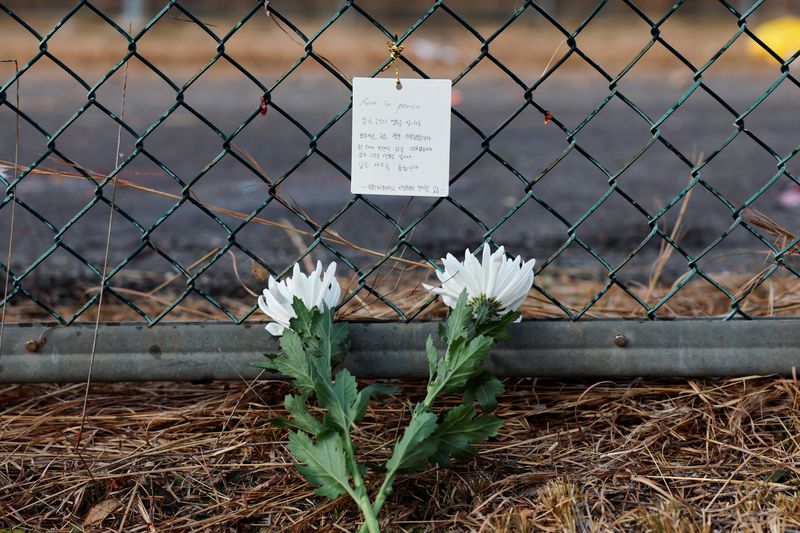South Korea orders airline safety probe after worst domestic crash kills 179 By Reuters

Written by Jo Min Park and Hongji Kim
MUANE COUNTY, South Korea (Reuters) – South Korea’s acting President Choi Sang-mok on Monday ordered an emergency safety inspection of aviation operations in the entire country as investigators work to identify the victims and determine the cause of the deadliest air disaster on South Korean soil.
All 175 passengers and four of the six crew members were killed when the Jeju Air Boeing (NYSE:) 737-800 touched down and skidded off the end of the runway at Muan International Airport, exploding in a fireball when it struck a wall. Two crew members were recovered alive.
Choi said at a disaster management meeting in Seoul that the top priority now is to identify victims, support their families and treat survivors.
“Even before the final results come out, we ask officials to transparently disclose the incident investigation process and immediately inform the bereaved families,” he said.
“Once the accident recovery process is completed, the Ministry of Transport is required to conduct an emergency safety inspection of the entire aircraft operating system to prevent recurrence of aircraft accidents,” he added.
As a first step, the Ministry of Transport announced plans to conduct a special inspection of all 101 Boeing 737-800 aircraft operated by South Korean airlines starting Monday, focusing on the maintenance record of key components.
The 737-800 is one of the most widely used aircraft in the world and has an overall strong safety record. It was developed long before the MAX was involved in Boeing’s recent safety crisis.
Jeju Air flight 7C2216, coming from the Thai capital Bangkok, was trying to land shortly after 9 a.m. (0000 GMT) on Sunday at the airport in the south of the country.
Fire and transportation officials said investigators are examining bird strikes, whether any of the plane’s control systems malfunctioned, and the pilots’ apparent rush to attempt a landing shortly after the emergency was declared as possible factors in the crash.
Experts say many questions remain, including why the plane, powered by two CFM 56-7B26 engines, appeared to be traveling so fast and why its landing gear did not appear to have dropped when it skidded down the runway and hit a concrete embankment.
“I can’t think of any reason why I would land like that,” said aviation safety expert John Nance, a former military and commercial pilot who flew 737s for Alaska Airlines.
The plane descended at a high speed, and based on the video, the pilots did not or could not take steps to slow it down, Nance said.
CFM International is a joint venture between GE Aerospace and France Safran (EPA:).
Transportation Ministry officials said Monday that as the pilots approached the plane, they informed air traffic control that the plane had been hit by a bird strike, shortly after the control tower warned them that birds had been spotted in the vicinity.
The pilots subsequently issued a warning on May Day and indicated their intention to abandon the landing, turn around, and try again. Shortly thereafter, the aircraft touched down the runway in a belly landing, touching down approximately 1,200 m (1,310 yd) along the 2,800 m (3,062 yd) runway and sliding into the embankment at the end of the landing runway.
“You don’t have a wall”
Officials are investigating the role the local antenna, located at the end of the runway to aid landing, played in the accident, including the concrete embankment on which it was standing, Transport Ministry officials said at a news conference.
“At an airport that has a runway at the end, usually, there is no wall,” said Christian Beckert, an aviation safety expert and Lufthansa pilot based in Munich. “Maybe you have an engineering material blocking system, which allows the plane to sink into the ground a little bit and brake.”
The accident killed most of the local residents who were returning from vacation in Thailand, and two Thai citizens also died.
“I can only accept this and come to terms with it,” said Boonchoai Duangmani, 77, the father of one of the Thai victims. “When I think about it, I remind myself that it was just an accident. It’s something that could happen to anyone. So, I’ve come to terms with it because no matter what I do, my daughter will not come back.”
On Monday morning, investigators were trying to identify some of the more than two dozen remaining victims, while grief-stricken families waited inside the Moan Airport terminal.
Park Han-shin, who lost his brother in the accident, said authorities told him that his brother had been identified but he was unable to see his body.
Park called on the families of the victims to unite in response to the disaster, citing the sinking of a ferry in 2014 that killed more than 300 people. Many relatives of the victims of the Sewol ferry disaster complained that the authorities took a long time to determine the identity of the dead and the cause of the accident.
Transport Ministry officials said the plane’s flight data recorder had been recovered but appeared to have suffered some external damage and it was not yet clear whether the data was intact enough to be analysed.
The recorder has been flown to Seoul and analysis will begin when a team from the US National Transportation Safety Board and officials from Boeing arrive in the country late Monday, officials told reporters.
Muan International Airport remains closed as of Wednesday, but the rest of South Korea’s international and regional airports, including the main Incheon International Airport, are operating as scheduled.
Jeju Air shares hit an all-time low on Monday, trading down as much as 15.7%. Boeing shares fell by about 2%.
The 15-year-old plane’s construction and design are unlikely to be factors in the accident, but the incident highlights a “major risk” to the plane maker’s shares, Wolff Research analyst Miles Walton wrote in a note.
Under global aviation rules, South Korea will lead a civil investigation into the crash and will automatically involve the National Transportation Safety Board since the plane was designed and manufactured in the United States.
A large memorial was erected at the district gymnasium about 9 kilometers from the crash site, where people including Acting President Choi attended to pay their respects.

Choe, who is overseeing recovery and investigation efforts, became acting president just three days ago after the country’s president and prime minister were removed due to the imposition of short-lived martial law.
The aviation insurance industry could be looking at a claim of about $15 million to $20 million under an airline hull insurance policy, and total passenger liability claims of $120 million to $180 million due to the accident, according to Marcos Alvarez, managing director of the global insurer. Ratings in Morningstar DBRS.
https://i-invdn-com.investing.com/news/LYNXMPEB2C0AG_L.jpg
2024-12-30 20:34:00





